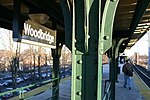Woodbridge Township School District
The Woodbridge Township School District is a comprehensive community public school district that serves students in kindergarten through twelfth grade from Woodbridge Township in Middlesex County, New Jersey, United States. All schools are accredited by the Middle States Association of Colleges and Schools. As of the 2018–19 school year, the district, comprising 26 schools, had an enrollment of 13,888 students and 1,122.7 classroom teachers (on an FTE basis), for a student–teacher ratio of 12.4:1. The high schools offer more than 150 courses, including Advanced Placement, college preparatory, business, vocational and cooperative work/study programs. The district is classified by the New Jersey Department of Education as being in District Factor Group "DE", the fifth-highest of eight groupings. District Factor Groups organize districts statewide to allow comparison by common socioeconomic characteristics of the local districts. From lowest socioeconomic status to highest, the categories are A, B, CD, DE, FG, GH, I and J.
Excerpt from the Wikipedia article Woodbridge Township School District (License: CC BY-SA 3.0, Authors).Woodbridge Township School District
School Street,
Geographical coordinates (GPS) Address Nearby Places Show on map
Geographical coordinates (GPS)
| Latitude | Longitude |
|---|---|
| N 40.55521 ° | E -74.280274 ° |
Address
School Street 414
07095
New Jersey, United States
Open on Google Maps








